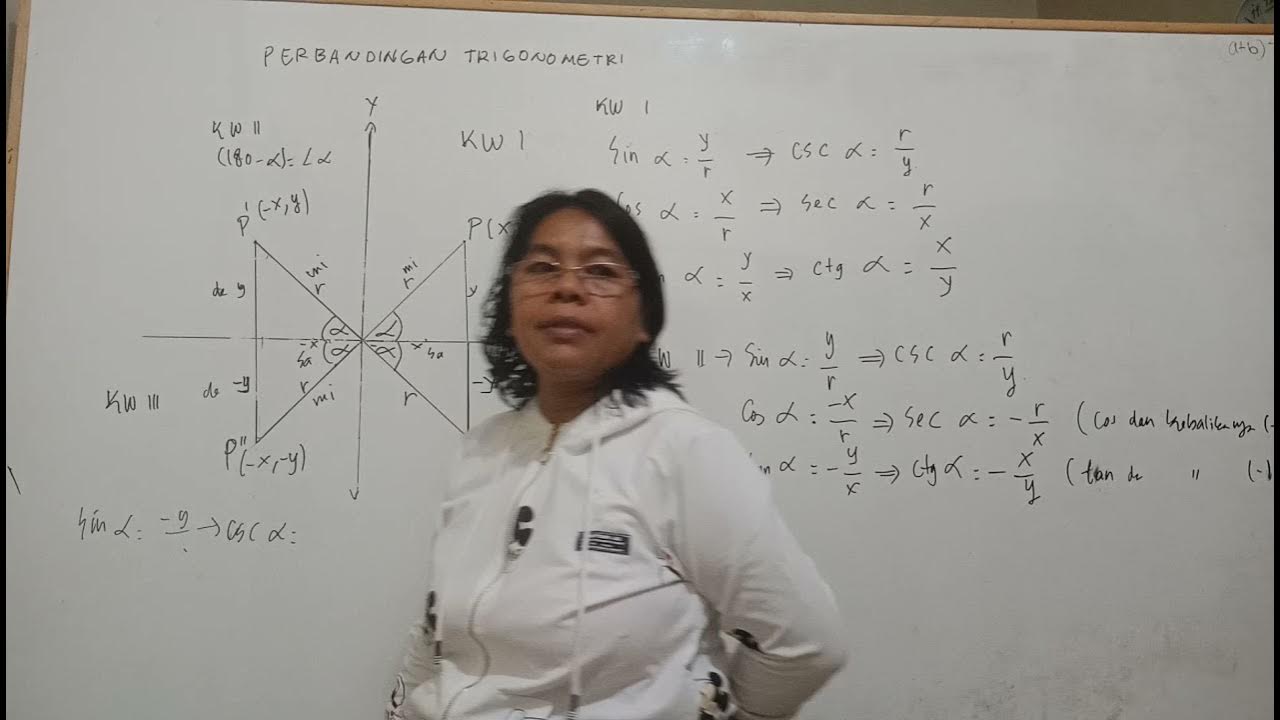P3 TRIGONOMETRY (BASICS) | A LEVELS | MATHS 9709
Summary
TLDRThis transcript explains key trigonometric concepts, focusing on angles, radians, and quadrants. It emphasizes understanding exact values for sine, cosine, and tangent for specific angles like 30°, 45°, and 60°. The speaker walks through solving trigonometric equations by calculating angles, quadrants, and basic angles. Concepts such as the relationship between an angle's trig ratio and its basic angle are highlighted, alongside the importance of adjusting quadrant signs. Real-world examples are provided, with step-by-step guidance on calculating trigonometric ratios without a calculator.
Takeaways
- 📐 Understanding the relationship between degrees and radians: 180 degrees is equivalent to π radians, 360 degrees is 2π, 90 degrees is π/2, 45 degrees is π/4, and 30 degrees is π/6.
- 🔢 Always check if the answer is required in exact form when solving trigonometry questions.
- 📊 You need to know the exact values of sine, cosine, and tangent for angles like 30, 45, and 60 degrees, as they may not be provided in the exam.
- 🧮 Calculator usage may vary; some calculators are allowed, but exact values should be prioritized.
- 🖼️ When finding the area of a shaded region or solving for angles, it's important to be familiar with quadrant systems in trigonometry.
- 📏 Every angle has two key values: the actual angle (measured from 0 in an anti-clockwise direction) and the basic angle (acute angle made with the x-axis).
- 📈 The trigonometric ratio of any angle θ is equal to the trig ratio of its basic angle α, after adjusting for the quadrant's sign.
- 🧠 Quadrants affect the signs of trigonometric ratios. For example, in the third quadrant, tan(225°) has a positive sign.
- ➕ To calculate cos(2π/3), first convert to degrees (120°) and then apply the sign adjustment for the second quadrant: cos(120°) = -1/2.
- 📊 Examples of finding sine, cosine, and tangent using basic angles were provided for practice, such as cos(210°) and sin(150°).
Q & A
What is the radian equivalent of 360 degrees?
-The radian equivalent of 360 degrees is 2π radians.
What are the exact values of sine, cosine, and tangent for 30 degrees?
-For 30 degrees: sin(30) = 1/2, cos(30) = √3/2, and tan(30) = 1/√3.
Why is it important to know the exact trigonometric values of specific angles?
-In trigonometry questions that require exact answers, calculators may not provide these values directly, so knowing the exact values of sine, cosine, and tangent for angles like 30°, 45°, and 60° is essential.
How are angles measured on a unit circle in the counterclockwise direction?
-Angles are measured starting from 0° and increasing in the counterclockwise direction. For example, 90° is π/2 radians, 180° is π radians, and 360° is 2π radians.
What are the two main values associated with any angle?
-Each angle has two main values: the actual angle (measured from zero in the counterclockwise direction) and the basic or acute angle (the acute angle it makes with the x-axis).
What is the relationship between an angle and its trigonometric ratio in different quadrants?
-The trigonometric ratio of any angle θ is equal to the trig ratio of its basic angle α, adjusted for the quadrant's sign. Each quadrant changes the sign of sine, cosine, and tangent values accordingly.
How do you find the basic angle for cos(210°)?
-The basic angle for cos(210°) is 30°. The value of cos(210°) can be determined using the value of cos(30°), but since 210° is in the third quadrant, the value will be negative.
What is the cosine of 2π/3 radians?
-The angle 2π/3 radians is equivalent to 120°. The cosine of 120° is -1/2, as it lies in the second quadrant where cosine is negative.
How do you calculate sin(150°)?
-The basic angle for 150° is 30°. Since 150° lies in the second quadrant, where sine is positive, sin(150°) is equal to 1/2.
What is the significance of knowing quadrant signs in trigonometry?
-Knowing the quadrant signs helps adjust the values of sine, cosine, and tangent based on the angle’s location, as different quadrants have different signs for these trigonometric ratios.
Outlines

Cette section est réservée aux utilisateurs payants. Améliorez votre compte pour accéder à cette section.
Améliorer maintenantMindmap

Cette section est réservée aux utilisateurs payants. Améliorez votre compte pour accéder à cette section.
Améliorer maintenantKeywords

Cette section est réservée aux utilisateurs payants. Améliorez votre compte pour accéder à cette section.
Améliorer maintenantHighlights

Cette section est réservée aux utilisateurs payants. Améliorez votre compte pour accéder à cette section.
Améliorer maintenantTranscripts

Cette section est réservée aux utilisateurs payants. Améliorez votre compte pour accéder à cette section.
Améliorer maintenantVoir Plus de Vidéos Connexes

Perbandingan Trigonometri

Cara Menentukan Nilai Perbandingan Trigonometri Sudut Lebih Dari 360 Derajat Lebih Dari Satu Putaran

CARA MENGHITUNG SUDUT TRIGONOMETRI‼️

Belajar Matematika Dengan Mudah - Perbandingan Trigonometri Dalam Segitiga Siku-siku.

Matematika SMA - Trigonometri (4) - Relasi Antar Sudut Trigonometri Tingkat Lanjut (A)

Konversi Sudut - Ukuran Derajat - Konversi Radian ke Derajat dan Sebaliknya - Trigonometri Part 3
5.0 / 5 (0 votes)
